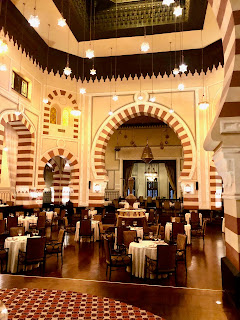By the time we flipped our calendars into March, our departure date, March 6, was fast approaching. The Coronavirus had hit China, a cruise ship in Japan and a few other contained areas. We actively debated the wisdom of going on our trip for days. We had spent a lot of time and energy planning. We were going to lose a ton of money if we cancelled, but that wasn't the main motivator. The truth is, we never saw the risks to be as grave as they really were, and we didn't see the virus spreading with the pace and effect it ultimately exhibited. Maybe no one saw these things at that point.
Anyway, on March 6 we flew British Air through London into Cairo. There was a sizable group from a local girls' high school on our London plane, all headed to South Africa. We were pretty upbeat. On arrival in Egypt we had our temperatures taken and had to submit answers to a short questionnaire. No problem.
Our tour company was Nubia Tours. The head of the company got his training and connections through Abercrombie & Kent, and came very highly recommended from our Travel Goddess (who retired suddenly on January 1). We were traveling alone. It was just Cheryl and me, a driver and a guide who was also an Egyptologist. That part --- the flexibility, the social distancing, the no-large-group logistics -- those features were critical now.
We spent the first few days at The Kepinkski Nile Hotel, situated on the Nile among other, fancier and more upscale properties such as the Intercontinental and The Ritz Carlton. We have no complaints about the Kempinski. The hotel felt clean and cozy; the buffet breakfast was very good also. However, after the few days in Egypt, we decided to stop going to breakfast and instead opted for coffee and Clif Bars in our room.
Unfortunately, it's not at all easy to even go for a walk in downtown Cairo. No one pays attention to lights and there are few to begin with. The Egyptian taxis, tuk-tuks and mini-buses used by the locals for transport are insane; they stop and drive in unpredictable ways. We saw at least several accidents. This is not the place to go out for an evening stroll, unfortunately.
 |
| Lighting store in the Old Islamic Quarter, Cairo |
The first few days of touring included a trip to the Old Islamic Quarter and the Khan El Khalili Bazaar, one of the oldest in the Middle East, dating back to the 14th century. The bazaar is a lot of fun for shopping, but the touts can be a bit aggressive. Fortunately, we kept to better quality establishments and our local guide was quite knowledgeable. Merchants brought out tea, coffee or Coke as part of "Egyptian Hospitality." A few days later came back to have an early dinner at the wonderful old Neguib Mahfouz Restaurant, currently run by the Oberoi group and located in the heart of the bazaar. The food is classic Arabian, with the best falafel, lamb kafka, eggplant, kebbe -- all that good stuff, and all top quality.
The highlight of our time in Cairo was visiting the Sphinx and pyramids in Giza, Saqqara, and Dahshour. At Saqqara, a field of royal tombs about 3.5 km long, the Bent and Step Pyramid are the earliest of all antiquities, from 2300 B.C. and they are remarkably well-preserved. At Giza, the "Great Pyramids" are the only present-day survivors of the Seven Wonders of the World, We also visited a "solar" boat beside the Great Pyramid of Cheops -- an entire boat reconstructed after its discovery in 1954, buried next to the king for his use in the afterlife.
 |
| The mysterious Sphinx |
No trip to Cairo would be complete without a trip to The National Museum, which includes The Treasure Room associated with King Tut (Tutenkhamun). It is amazing and sumptuous, a must see experience. The gold mask found on the boy king by Howard Carter in 1925 is iconic and one of the best known works of art in the world. It dates from 1323 B.C. No photos are allowed in the Treasure Room.
https://images.app.goo.gl/nnyRSNc3XdtgxvG57
The last day in Cairo we toured Coptic Cairo and St. Sergius, which is considered to be a resting place of the Holy Family, who stayed there during their flight to Egypt 2000 years ago.
 |
| Stain glass windows and wood carving details at St. Sergius |
The next part of our trip flew us down to Aswan, first to see the romantic and majestic Philae Temple by motorboat, on the island of Agika. It was saved from flooding by world heritage organizations and moved to its current location on Agika.
We were honored to stay at The Old Cataract Hotel in Aswan, a Sofitel property that boasts an incredible view and lots of history. https://en.wikipedia.org/wiki/Old_Cataract_Hotel. The hotel was built in 1902 and a modern tower was built in 1961. Winston Churchill stayed here for a time, and Agatha Christie wrote parts of Death on the Nile here. We decided to have a drink at the lovely bar on the veranda, maybe the most expensive martinis ever (I think $25. per). The Old Cataract is a jewel, steeped in beauty and history, and well worth the effort and price to stay there.
 |
| The 1902 Dining Room at The Cataract |
While in Aswan we took a short regional flight and then rode by van to the small fishing town Abu Simbel to visit two spectacular temples to Ramses II. Both temples are fronted by colossal seated figures up to 20 meters high. With the rising waters of Lake Nasser threatening the temples, an effort led by UNESCO deconstructed the temples block by block and reassembled them with a higher vantage point on the hillside.
 |
| One of two temples to Ranses II with enormous figures at entrance |
Leaving Abu Simbel a sandstorm kicked up, making our return to The Cataract impossible. The police instructed all vehicles to turn around and stay in Abu Simbel. We made arrangements in a hotel and stayed the night with no problem. The sandstorm was a first for me, and looked a lot like a snow storm. I noticed that car and van owners used sponges and rags to put soap on their vehicles to protect them from "sandblasting." The next morning we were able to leave early, and made a stop at a Bedouin camp for some delicious Turkish coffee.
We traveled from Aswan by van into Luxor, which is a tourist hot spot because of The Valley of The Kings and Queens. On our way we visited Kom Ombo, the Ptolemaic Temple dedicated to the crocodile god Sobek and The Falcon-headed Horus, god of the morning sun.
The Valley of the Kings and Queens is essentially a vast City of the Dead on the west bank of the Nile where ornate and sumptuous tombs were built into the rock. Much of the time large tourist sleeper barges are used to bring people to the area. During our visit one of those barges was the site of a Coronavirus outbreak, the first serious situation of its kind in Egypt. The boat was quarantined. We were so grateful not to have included a boat-trip as part of our itinerary. It was a key move. Honestly, we have never been "cruise people," and based on recent history, I've sworn them off for the foreseeable future.
Among the major sights in the Valley of the Kings and Queens is the stunning Tomb of Nefretari. Long praised as the most beautifully-decorated of all the tombs on the West Bank of Luxor, this masterpiece of Egyptian art was restored by the Egyptian Antiquities Authority and the Getty Conservation institute in the USA. Specialists worked for 6 years to clean the paintings and re-affix them to the plaster walls from where they had been flaking, and today it is hardly conceivable that such vibrant colors have actually not been retouched since they were first laid thousands of years ago. The tomb is currently opened for limited number of visitors based on the first come, first get and an extra charge as well. It is undoubtedly worth it, however, since Nefretari's Tomb is superb and perhaps my favorite of all sights. It is often referred to as "the Sistine Chapel of Egyptian Art."
 |
| Two photos from Queen Nefretari's tomb |
We stayed at the Hilton Hotel in Luxor, which was not a stand-out experience, but certainly fine for our purposes.
While we did not stay on a barge on the Nile, we did take a lunch trip aboard the classic Egyptian sailing vessel, a felucca. The crew served us an enormous and very tasty spread of hot and cold mezze while we slowly cruised the river.
 |
| Our guide and expert Egytologist Hassan digs in to lunch on the felucca |
The next day we visited the Ptolemaic Temple of Goddess Hathor in Dendera. This wonderfully preserved temple complex is a rare sight to behold, complete with a massive stone roof, dark chambers, underground passages and towering columns inscribed with hieroglyphs. The main Temple of Hathor is almost intact. Hathor was the goddess or pleasure and of love, usually represented as a cow, or a woman with a cow’s head. She was the beneficent deity of maternal and family love, of beauty and light; the Greeks associated her with Aphrodite.
 |
| Interior of the Goddess Hathor in Dendera |
Our final stop was Abydos. Abydos stands apart from other temples in Egypt as it was in fact the center of a holy city dedicated to Osiris, King of the Underworld. Abydos was the burial- place for pre-dynastic kings and Pharaohs dating back to the fourth millennium BC. The walls are covered with reliefs, some of the most beautiful in all Egyptian Art.
On March 15, we learned that the country of Jordan was closing its borders as a protective measure. The U.S. also began to restrict access, and Egypt was decreasing air service. Our tour company said it could not support the Jordan portion of our trip and arranged to refund its cost. We made some hasty arrangements for air travel back to Boston via Heathrow, and flew to Cairo on March 16 to begin the homeward journey.
The flights home were uneventful and on time. As we approached Boston, the British Air crew distributed a questionnaire to fill out. There was a "health screening" when we deplaned, where we handed in our forms and random people had their temperature taken. It went very smoothly. The whole process from plane to taxicab took one hour.
Man, it was good to be home.
Truly our trip to Egypt was fraught with issues and worries over the world-wide virus, and we had to roll with the punches. But it is for certain that the Egyptian antiquities, temples and tombs were the most impressive sight this traveler has ever seen. The are incomparable in size, ingenuity and even beauty. I hope you get to see them. But wait awhile.

